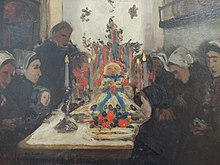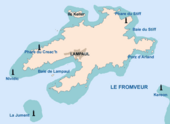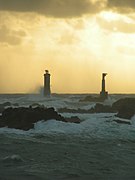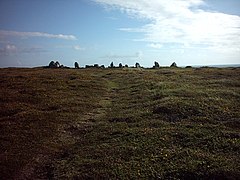Ouessant
| Ouessant | ||
|---|---|---|

|
|
|
| region | Brittany | |
| Department | Finistère | |
| Arrondissement | Brest | |
| Canton | Saint-Renan | |
| Coordinates | 48 ° 27 ′ N , 5 ° 6 ′ W | |
| height | 0-61 m | |
| surface | 15.58 km 2 | |
| Residents | 835 (January 1, 2017) | |
| Population density | 54 inhabitants / km 2 | |
| Post Code | 29242 | |
| INSEE code | 29155 | |
| Website | www.ouessant.fr | |
Ouessant ( Breton Enez Eusa , English Ushant ) is a French island and a municipality with 835 inhabitants (as of January 1, 2017) off the Breton coast in the Atlantic. It is the westernmost settlement in France (excluding overseas territories ). The island belongs to the Brittany region , the Finistère department , the Brest arrondissement and the Saint-Renan canton .
Location and nature
The 15.58 km² island is located about 20 kilometers west of the coast of Finistère in the far east of the Celtic Sea . The island represents the westernmost part of mainland France and, like the Isles of Scilly in the north, marks the extreme western end of the English Channel and the northern end of the Iroise sea area .
Like almost all Breton islands, Ouessant consists of granite rock . At its highest point, the island reaches 61 m . The shape of the island is vaguely reminiscent of a crab.
Economy and tourism
The municipality of Ouessant officially consists of 92 hamlets ; The main town and seat of the administration is Lampaul.
Many residents now live from tourism and the service industry. The number of workers in the nautical professions ( fishermen , seafarers or lighthouse keepers ) is falling. Agriculture hardly plays a role anymore. The island is important for beekeeping because it has a pure, Varroa- free population of Breton dark bees .
In the summer months, numerous day tourists come to explore the island for a few hours. There are several smaller hotels and private accommodations available for guests who stay longer . The island is scenic, but offers neither major beaches nor outstanding tourist attractions. Worth mentioning the location in the west, 55 meters high are lighthouse Phare du Creach with a small museum about maritime signaling devices, which in the eastern Phare du Stiff which is accessible to visitors, which runs between the two lighthouses coastal path and the church in Lampaul.
There is a daily ferry connection to Ouessant from Brest via the much smaller, inhabited neighboring island of Molène , which is called on the way. There is also a ferry connection from the fishing village of Le Conquet to Ouessant, by the ferry Le Fromveur. There is also a small airfield that is approached from Brest Airport .
Importance for seafaring
The island marks the entrance to the English Channel for ships coming from the south-west of the Atlantic. The Phare du Créac'h lighthouse, better known as the Ushant Lighthouse , can be seen from afar and is the first beacon for seafarers after crossing the Bay of Biscay and the most important course mark for entering the English Channel. To the northwest of the lighthouse is a traffic separation area for regulating shipping when changing course from the Atlantic to the English Channel and vice versa. A radar tower next to the Phare du Stiff lighthouse in the northwest of the island is used to control the traffic separation area. Next to it is a transmission mast for NAVTEX .
- Ile d'Ouessant
The Pen-ar-Lan stone circle
Historical meaning
"The island at the end of the world" had several megalithic systems , including the "Pagan Temple " so named by Admiral Antoine-Jean-Marie Thévenard in 1800. The angular enclosure , a so-called "Quadrilatère", is only preserved as a watercolor by the painter Jean-Baptiste Debret . The small oval stone circle of Pen-ar-Lan in the far west of the island has survived .
Archaeological excavations began in 1988. They indicate a human presence during the Neolithic period. From the Late Bronze Age to the Early Iron Age (750 to 450 BC), the village was not the only settlement on the island. Traces of a shell cult indicate the worship of a Breton sea and fertility goddess, reported by Artemidor of Ephesus . The remains also show exceptionally rich traces from Roman times. Thousands of ceramic artefacts prove that this village also absorbed the protoceltic cultural currents. According to legend, Paulus Aurelius ( Saint Pol ), who proselytized the island, founded a monastery on Ouessant around 517; another was founded by Gildas the Wise. Even after 1900, old ballads were recorded on Ouessant in the Breton language, which were previously considered to be extinct.
Ouessant is known for its maritime past, both in terms of fishing, but, and above all, for its outstanding function as a landmark in the English Channel . The lighthouse Phare du Stiff , the construction of which was started in 1695 under the fortress builder Vauban and finished in 1700, was the first French lighthouse on the English Channel (see also list of lighthouses in France ). In 1778 , 1781 and 1794 important naval battles took place in the narrower and wider sea area off Ouessant .
From July 1940 until the summer of 1944. Northern France was by troops of the Wehrmacht occupied by France within a few weeks in the western campaign for Armistice of Compiegne had forced. Then they built a chain of defensive structures ( Atlantic Wall ) on the English Channel coast . On June 6, 1944 (" D-Day "), the Allies landed in Normandy . Some Wehrmacht soldiers were stationed on Ouessant. During the Battle of Brest they broke away from their troops, sided with the island's population and shot a German boat that was supposed to look for them as "missing persons".
Ship accidents
In 1896 the Drummond Castle sank after hitting a rock. 243 of the 246 people on board were killed.
In May 1922, the British passenger steamer Egypt collided with a French freighter 25 miles off the island and sank within a few minutes, killing 87 passengers and crew. It was one of the worst naval tragedies in this region in peacetime.
On March 16, 1978, ten kilometers from the island, the oil tanker Amoco Cadiz sank and polluted the coast of Brittany.
Ouessant as a motif in painting, literature, film, photography and music
The painter Charles Cottet recorded the laying out of a three-year-old English girl, who drowned in the sinking of Drummond Castle , in an oil painting that is now in the Petit Palais (Paris) . The girl and the mourners are dressed in traditional Breton costume. Another version of the picture is in the museum in Nantes .

The French organist and composer Charles Tournemire (1870–1939) owned a house on Ouessant and allowed the wildness and unrestrained forces of nature on this island to flow into his late romantic compositions. Yann Tiersen created a musical memorial to the island he also lives on with his piano pieces on the 2016 album Eusa I.
The young Bernhard Kellermann stayed on the island for some time. This is the setting for his story The Sea (1910).
In 1929, director Jean Epstein shot the silent film Finis Terræ with residents of the island , some of which is set on Ouessant. Also in the French feature film The Lighthouse Keeper's Wife from 2004, a memorial was made to the meager life on the rough island.
The Phare de la Jument in the southwest of Ouessant is the motif of the well-known photograph by Jean Guichard from 1989, which shows the lighthouse keeper in the open door of the tower, who is being enveloped by a huge wave.
Population development
| year | 1962 | 1968 | 1975 | 1982 | 1990 | 1999 | 2010 | 2017 |
| Residents | 1938 | 1814 | 1450 | 1221 | 1062 | 932 | 871 | 835 |
| Sources: Cassini and INSEE | ||||||||
See also
literature
- Le Patrimoine des Communes du Finistère. Flohic Editions, Volume 2, Paris 1998, ISBN 2-84234-039-6 , pp. 843-851.
- Jean-Paul Le Bihan, Jean-François Villard: Archeologie d'une île à la pointe de l'Europe: Ouessant, Tome 1, Le site archéologique de Mez-Notariou et le village du premier age du Fer . 2007
Web links
- Official website (French)
- Tourist Office of the Island (French)
- Traditional, Spanish Ladies , credited to Iron Men & Wooden Ships , by Frank Shay (English)
Individual evidence
- ↑ Lars Hellwinkel: Hitler's Gate to the Atlantic . Links Verlag 2012.
- ↑ Illustration on parismuseescollections.paris.fr






